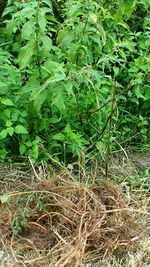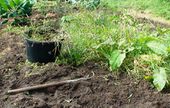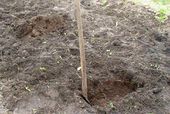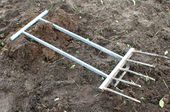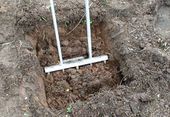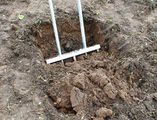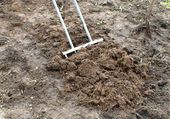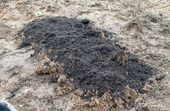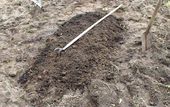Soil management
Topic in Gardening courses
- Consider to merge this page with Preparing the soil
Chunks of information
Stinging nettle
- The use of the stinging nettle for soil improvement: The photo shows the larger species of the stinging nettle (Urtica dioica) with roots that were dug out. This plant can have good use for improving the soil. The long roots bring many minerals from lower down to the upper soil. The plant can grow up to 2 meters high and produces a lot of material for mulch or compost, so it is an excellent green fertilizer.
The roots also make the soil very loose and crumbly.
- The following is a quote from http://en.wikipedia.org/wiki/Stinging_nettle:
"The growth of stinging nettle is an indicator that an area has high fertility (especially phosphorus) and has been disturbed.
- Nettles contain a lot of nitrogen and so are used as a compost activator or can be used to make a liquid fertiliser which although somewhat low in phosphate is useful in supplying magnesium, sulphur and iron. They are also one of the few plants that can tolerate, and flourish in, soils rich in poultry droppings."
- You can use the nettles for most excellent fertilizer. Put the plants in a ton of water and let it stand for a few weeks. This fertilizer is rich of nitrogen and also of minerals such as magnesium, sulphur and iron. This fertilizer can be applied by pouring it next to vegetables or flowers. It is taken in by the plants very fast.
Grelinette (garden fork)
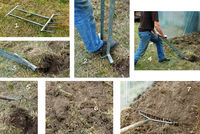
- The grelinette is a very useful tool in organic farming. It doesn't disturb the layers of the soil and it's much easier than a spade to prepare a soil for planting or sowing.
- Disturbing the soil layers: Top soil: micro-organisms that need oxygen. Lower: micro-organisms that need oxygen and bacteria that can do without. Still lower down: micro-organisms that don't like oxygen.
In addition to this, bugs and small animals that live in the soil. For organic farming we need these micro-organisms. They make fertilizers and live in symbiosis with the roots of plants. Plants have their typical micro-organisms around them that feed their roots and protect them against disease. The best is to keep the soil covered with green like in grassland, or with a layer of mulch, like in a forest. I'll write about this more later. Once a soil is treated well it becomes a bit like a sponge and doesn't need much treatment. In ancient times many peoples didn't use plows that turned the soil upside down, they used a kind of cultivator-plow, a pin pulled through the ground. It didn't disturb the soil layers.
How to prepare a rock hard soil
- Temperate climate.
I would use two methods, one mechanical and the other one applying composting and mulching methods.
I don't know if 'rock hard ground' means that there literally are rocks in the soil? In that case you'll have to remove the rocks by hand. People have done this since oldest times and built banks around their fields with such rocks.
To do 2 acres by hand is much work, so i would use some kind of cultivator, like for example a Honda tiller. See: http://en.wikipedia.org/wiki/Cultivator You can usually rent such equipment for a few days. Maybe you can rent a tractor with cultivator to do the same. There also exist agricultural milling machines that really make the soil loose but which also disrupt the natural layer buildup of the soil, and they usually only work for the upper surface. A plough is of course another option.
Once the soil is loose, you can keep it loose by adding enough compost. You can also put a layer of any biological waste, grass, straw, weeds on top of the soil. The layer of mulch should be rather thick, up until one feet. You can move the mulch aside for planting and sowing, or for finer crops remove the entire sheet of mulch (use it on the compost heap) after it has been on the soil for at least half a year. Underneath the mulch develops rich microbe life and also rain wurms and other small creatures will help to improve the structure of the soil. The mulch will gradually disintegrate and add biological material to your soil.
To keep the soil in good order, it can be helpful to periodically sow fields with deep-rooting crops, such as lupine, hemp, or even stinging nettles. There may be other such crops available where you live.
I don't know if the pH of your soil is ok? If not, that also may badly influence the structure of the soil. You can do some test yourself with litmus paper or have it tested by a laboratory that does such things.
There could be problems with the different layers of the soil (so-called soil horizons): http://en.wikipedia.org/wiki/Soil_horizon To see the profile of your soil: dig a hole of several feet deep and make sure that with a spade you cut a very even surface on one of the walls of the hole. That's how you can study the soil horizons. You can also find out how deep the ground water level is. There may be some problem with an deeper layer in your soil that prevents plants from rooting deeply or reaching water in the ground. In that case you may have to apply deep-cultivation (the same as cultivating the surface but much deeper).
Double-digging a soil
When you have a small garden and you wish to maximize its production, here's something you can do. Loosen the soil deeper than you normally would. Normally we loosen a garden soil by spading it, one spade deep. I prefer using a digging fork that also goes one spade deep. What you actually do is bringing air into the top layer of the soil. Instead of going one spade deep, you can go ca twice as deep. Be careful though to not bring worthless sand to the top layer. Roots of plants need oxygen so they grow better in an airy soil. Also useful micro-organisms need oxygen. Many plants wish to root deeper if they could. So loosening the soil deeper than what is usually done allows these plants to grow bigger and longer roots. In that way the plant can take in more nutrients and the entire plant will grow faster and bigger. A soil that doesn't contain enough air and not enough humus will fill up or silt up when heavy rain falls on it. When there's not enough oxygen in the soil, this also lowers the pH of the soil. Many plants don't like this because they cannot take in the nutrients at a lower pH. Another reason why it is important to keep your soil loose.
See also French intensive gardening
Gallery
Soils want to be covered in some way. In nature, either mulch in the form of fallen leaves and branches cover a soil, or all kinds of plants grow there. In a garden, weeds grow where you don't remove them. These weeds can rival with your crops, but in times that no vegetables are growing there, weeds have a useful function.
Working with a rotary tiller on grass land. After cutting the grass we used this type of cultivator (rototiller or rotavator).
This is my newest garden tool. I let it be made by a blacksmith and the design is my own. The soil of my garden has been ploughed for many years by farmers using tractors. This method can cause what's called a plow pan. According to one definition "A plow pan is a subsurface horizon or soil layer having a high bulk density and a lower total porosity than the soil directly above or below it as a result of pressure applied by normal tillage operations, such as plows, discs, and other tillage implements." A plow keeps the upper layer of the soil loose, but the wheels of the tractor compact the soil underneath. This causes several problems. The first is that with excessive rainfall, water collects on top of the plow pan. The roots of plants can rot , soil micro-organisms that need oxygen die and the roots of plants cannot reach deeper layers. Another problem is that with dry weather, ground water cannot reach the top layer. In a good soil, ground water goes up to moisten the top layer through the process of osmosis. This garden tool works by driving the pin deep into the soil with your own weight and then pulling the top handle backwards using the instrument as a lever. It works well and fast and it breaks the plow pan. See also http://en.wikipedia.org/wiki/Hardpan
See also
External links
- CULTURAL PRACTICES Section of organic gardening course
- Grelinette Wikipedia
- Garden fork Wikipedia
Books
- Crops and Methods for Soil Improvement by Alva Agee ca 246 pages

